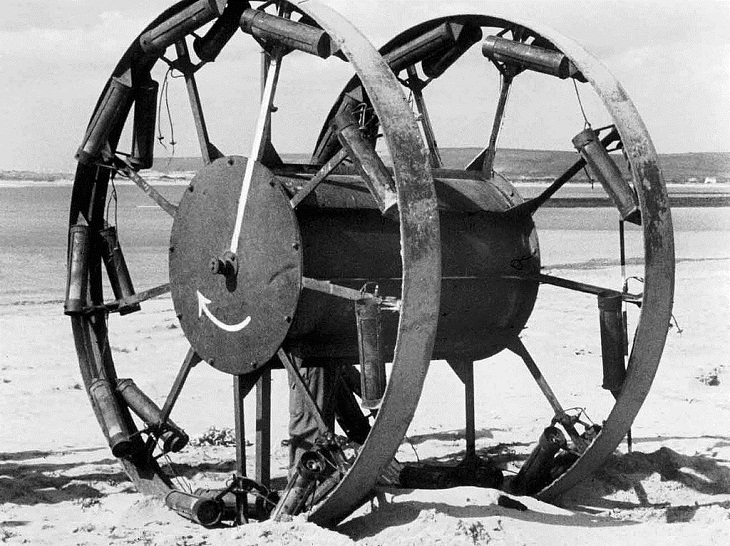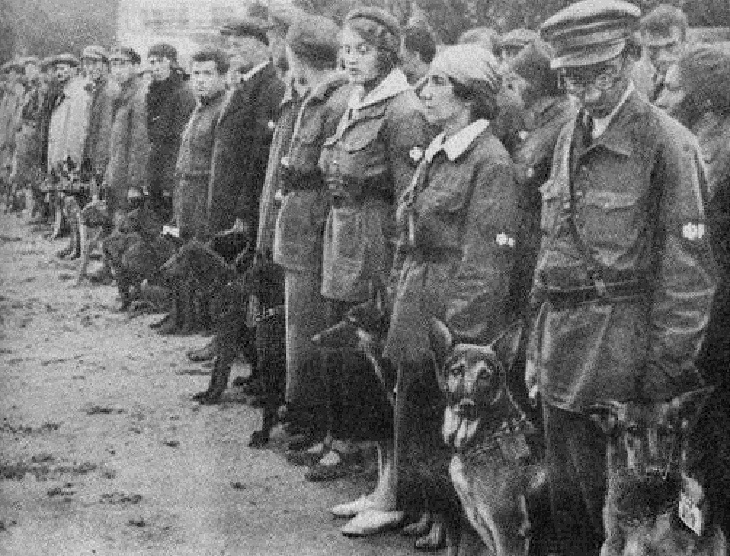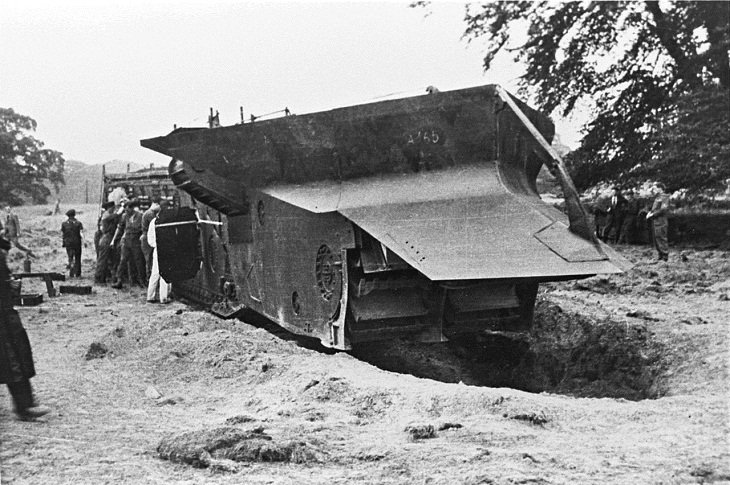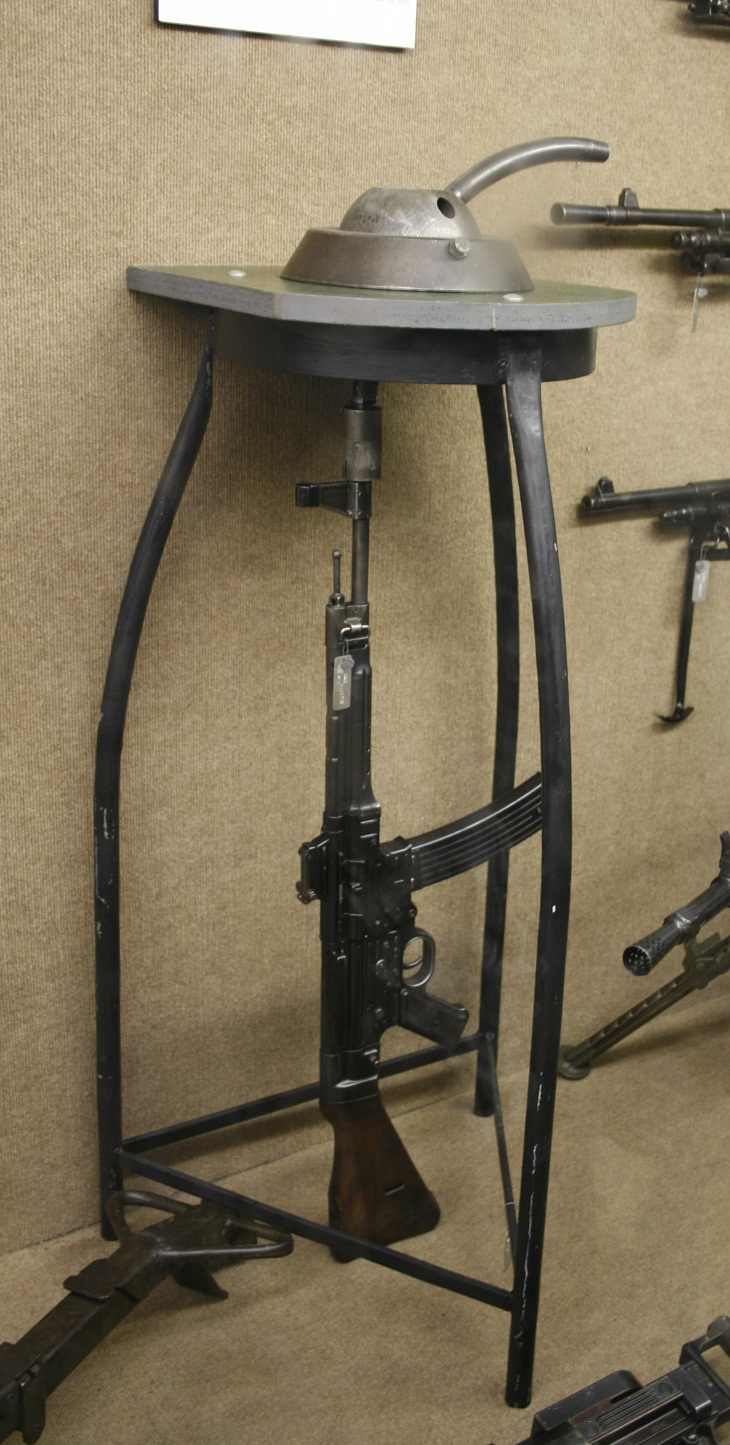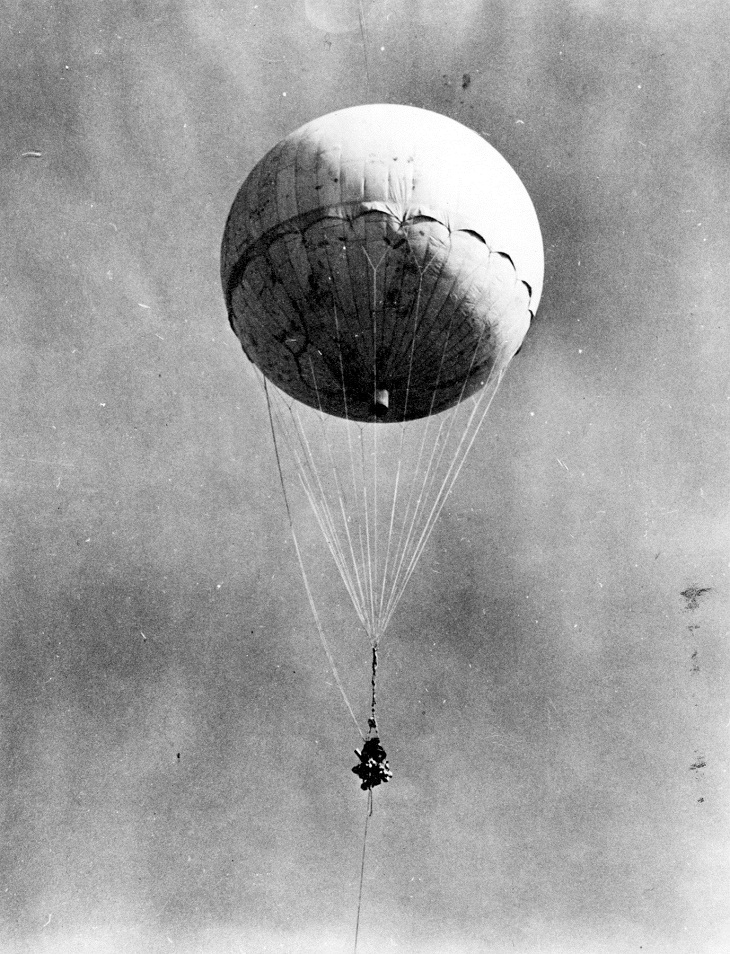Designed by the British Admiralty's Directorate of Miscellaneous Weapons Development, this inelegant carriage-like contraption was meant to breach the Germans' robust defenses in Normandy. Rockets attached to the rim of the two wheels propelled the device. A drum would be filled with explosives in the center. This large machine, known as the Panjandrum, was intended to smash into the enemy's defenses and explode. This would potentially create a breach large enough for a tank to pass through.
Unfortunately, during testing in 1943 and 1944, the Panjandrum lost control and kept veering off its intended path. Furthermore, the rockets attached to its wheels frequently failed or detached. During one test, officials had to duck for cover, and a cameraman was almost knocked out as the device charged around uncontrollably. Unsurprisingly, the Panjandrum was never used in action.
2. Explosive Rats
Yes, you read that right. During WWII, Britain's Special Operations Executive (SOE) devised a novel method for hiding, killing, and blowing things up. They planned to infest the German coal supply with dead rats stuffed with small explosives. The rats were supposed to explode after being strategically placed in a broiler at a military base or a steam engine. But the plan didn’t work as expected because the Germans discovered the container of dead rats. This caused widespread concerns in the German camp, and they began to hunt high and wide for more explosive rats.
In a report, the SOE noted, “The trouble caused to [the Germans] was a much greater success to us than if the rats had actually been used.”
3. Mine Dogs
Hitler's Nazi infantry invaded Soviet Russia in 1942 accompanied by German "Panzer" tanks, and the Soviets simply did not have enough anti-tank weapons to thwart them. To counter them, the Russians came up with a truly gruesome and cruel plan - suicide mine dogs. They strapped explosives around the dogs' bodies and then hid food under captured German tanks. To destroy the tanks, the canine soldiers were first starved before being trained to run beneath them, triggering explosives carried on their backs and causing explosions.
While many of the dogs did manage to take out a few tanks, the majority of them were unable to understand or perform the task on the battlefield. They would usually run back towards the Soviet lines, only to be shot and killed on sight.
4. Pigeon-Guided Rockets
Pigeons weren’t just used to deliver messages during the world wars; they were also employed as weapons. In 1943, when America desperately needed a way to reliably bomb targets in Nazi Germany, noted psychologist and inventor B.F. Skinner thought of using pigeons for the task. Skinner had previously trained the birds to pull levers for food as part of his psychological research and presented his plan to the National Research Defense Committee (NRDC). While the committee was doubtful, they granted Skinner $25,000 to get started.
Skinner chose pigeons for their vision and composure in chaotic environments. He designed a missile nose cone with three small electronic screens and three tiny pigeon cockpits. Images of the ground in front of the rocket were projected onto the screens. Skinner trained street pigeons to identify the target pattern and peck when they saw it. As soon as all three birds pecked together, the missile's path would be adjusted and guided to its target by cables attached to their heads.
However, even after a successful demonstration of the trained pigeons, the NRDC terminated the project.
5. Hitler's Gustav Gun
During the Second World War, Hitler was keen to penetrate the mighty fortifications of the French Maginot Line. This was the most significant physical barrier between him and the rest of Western Europe. The Nazi leader demanded a new weapon to achieve this goal. In 1941, German steelmaker and arms manufacturer Friedrich Krupp A.G. began building the Schwerer Gustav gun on Hitler’s orders.
Weighing 1,350 tons, the 155-foot-long (47.2 m) gun fired 10,000-pound (4,536 kg) shells from its mammoth 98-foot (30 m) barrel. Its massive size, however, proved to be its downfall. The enormous gun could only be transported by rail, making it a prime target for Allied bombers flying overhead. Within a year, the project was abandoned.
6. The Goliath Tracked Mine
The Nazis' Goliath, or Leichte Ladungsträger, was a miniature-tracking vehicle designed to deliver explosive devices. Steered remotely, it was called the "Doodlebug" by American troops. The Goliath was powered by two electric motors, which were later replaced by gas burners. In its compartments, the mini-tank contained 2,145 feet (653.7 meters) of cable that led back to the controller and was capable of carrying more than 100 pounds (45 kg) of explosives.
The Goliath was meant to slide under Allied tanks and detonate. However, enemy soldiers could quickly notice its long cable and neutralize the machine. Furthermore, at only 6 miles per hour (9.6 km/h), it was incredibly slow and easily became stuck. Yet, the Germans built 7,500 Goliaths during the war, indicating it wasn't a complete failure. At the time, the vehicle was not widely regarded as a success. However, it laid the foundation for later remote-controlled weapons to be developed.
7. 'Nellie'
'Nellie' was the nickname given to Cultivator No. 6, a trench-digging machine built by the Royal Navy. The idea for the mean machine was originally conceived by Winston Churchill during World War One and revived in 1939. Weighing 130 tons and measuring more than 75 feet (29 m) in length, the machine was intended to burrow toward the enemy line. This would create a trench wide enough for troops to advance behind. Nellie was armed only with a plow and a cylindrical cutter. A handful of these machines were constructed before the idea was dropped since they proved ineffective and impractical during the Second World War.
8. The German V-3 Cannon
The extremely long German V-3 cannon was a supergun designed during World War II. The 460-foot-long (140 m) cannon was capable of delivering a 140 kg (308.6 pounds) shell over a 165 km (102.5 m) range. It was intended to bombard London from an underground complex located 161 km (100 m) away at Mimoyecques, near Calais in northern France. The V-3's multi-chamber design allowed secondary charges to fire sequentially along the main barrel, accelerating a shell to the speed necessary for it to hit its target. A large concrete slab served as additional protection for a battery of 25 gun tubes that had been sunk into slanted ground tunnels.
The V-3 shell's velocity, however, was only 3,280 ft (1,000 m) per second when it became operational. This was about half the speed needed to reach London.
Hitler wanted to produce fifty of these weapons, but the Allied forces destroyed them before the original plans for the V-3 could be implemented. Eventually, only two miniature versions of the guns were used, to an unknown effect.
9. The Krummlauf
The Krummlauf (“curved barrel”) was created to solve the issue of shooting a rifle while taking cover. This bent barrel attachment for the Sturmgewehr 44 assault rifle was developed by Germany in World War II and included a periscope sight for firing around corners. According to the Imperial War Museums, the Krummlauf’s shape meant it could also be used from within a tank. It was also meant to counter other anti-tank weapons.
The attachment, however, proved to be utterly useless. After a few rounds, the bullets sometimes splintered in two before leaving the barrel, and the attachment itself deformed under intense pressure. Further tests revealed that the Krummlauf had a short lifespan and became unusable after firing 150-300 rounds.
The concept was a failure at the time but has been revived with some modern weapons that enable the user to engage the enemy without having to expose themselves.
10. The "Fugo" balloon bomb
In 1944, Japan developed a fire balloon, or "Fu-Go," which contained explosives or incendiary devices intended to pulverize the US. Made out of the bark of the mulberry tree, the paper balloons were 33 ft (10 m) in diameter and could lift approximately 454 kg (1,000 pounds). One balloon required roughly 30 men to prepare, and the process took 30 to 60 minutes. They were easy to produce and were intended to be dropped on American and Canadian cities, forests, and farmlands.
On November 3, 1944, Japan launched its first balloon, and within the next five months, around a thousand "Fu-Go" balloon bombs made it to North America. The bombs were released into the Pacific jet stream, which would silently transport the large devices from Japan to the US without the need for a pilot. Records show that about 9,000 balloon bombs were launched in total during the war, but only a few made landfall. Moreover, the damage they caused was negligible.
This experimental weapon was largely unsuccessful due to its uncontrolled nature and the uncertainty of atmospheric conditions.

